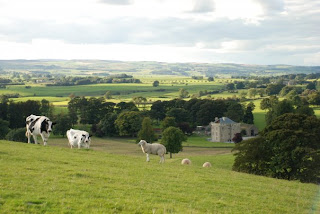Funny Historical Trivia & Jokes
 Did you know that the eighth Duke of Devonshire, known to his friends as "Harty Tarty," was told off by Queen Victoria for picking his nose at dinner. A poor shot, he once killed a pheasant and his gun-dog and wounded two bystanders (one of whom was his chef) with a single cartridge.
Did you know that the eighth Duke of Devonshire, known to his friends as "Harty Tarty," was told off by Queen Victoria for picking his nose at dinner. A poor shot, he once killed a pheasant and his gun-dog and wounded two bystanders (one of whom was his chef) with a single cartridge.
"The British empire, sir," exclaimed an orator, "is one on which the sun never sets."
"And one," replied an auditor, "in which the tax-collector never goes to bed."
Baldulf, the medieval soothsayer, prophesied to the king that his favourite mistress would soon die. Sure enough, the woman died a short time later. The king was outraged at the soothsayer, certain that his prophecy had brought about the woman's death. He summoned Baldulf and commanded him, "Tell me when you will die!" Baldulf realized that the king was planning to execute him straightaway, no matter what answer he gave. "I do not know when I will die," he answered finally. "I only know that whenever I do die, you will die two days later."
The shortest war on record was between Zanzibar and Britain in 1896. Zanzibar, now part of Tanzania, surrendered after 38 minutes.
A bus load of tourists arrived at Runnymede on the banks of the Thames in Berkshire, England. They gathered around the guide who explained, "This is the spot where the Barons forced King John to sign the Magna Carta." A fellow at the front of the group asked, "When did that happen?" "1215," answered the guide. The man looked at his watch and said, "Looks like we just missed it by a half hour."
The Sillies...
Why were the early days of history called the dark ages? Because there were so many knights.
What kind of lighting did Noah use for the ark? Floodlights and Ark lights.
What English King invented the fireplace ? Alfred the Grate.
How was the Roman Empire cut in half? With a pair of Caesars.
Why did Henry VIII have so many wives? He liked to chop and change.
Asked by the court barber how he wanted his hair cut, the king replied, "In silence."
And The Utter Sillies...
Michelangelo's Mother: Can't you paint on walls like other children? Do you have any idea how hard it is to get that stuff off the ceiling?
Paul Revere's Mother: I don't care where you think you have to go, young man, midnight is past your curfew.
Mona Lisa's Mother: After all that money your father and I spent on braces, that's the biggest smile you can give us?
Mary's Mother: I'm not upset that your lamb followed you to school, but I would like to know how he got a better grade than you.




 Some of the Hammertons ran afoul Henry VIII with predictable results. The Crown was happy to annex their vast holdings from Lancaster to York.
Some of the Hammertons ran afoul Henry VIII with predictable results. The Crown was happy to annex their vast holdings from Lancaster to York.  Unfortunately, the up-to-do castle came to the attention of the Ministry of Defense during World War II to house POWs. The ruined castle was then shunted off to the Hammertons briefly before being sold to Harry Lund of Otley. Lund and archeologist Tot Lord stripped the castle of all accoutrements, including paneling, and sold them piecemeal to all comers. In 1965, the Hargreaves bought it and sold it in 2004 to the Shaws.
Unfortunately, the up-to-do castle came to the attention of the Ministry of Defense during World War II to house POWs. The ruined castle was then shunted off to the Hammertons briefly before being sold to Harry Lund of Otley. Lund and archeologist Tot Lord stripped the castle of all accoutrements, including paneling, and sold them piecemeal to all comers. In 1965, the Hargreaves bought it and sold it in 2004 to the Shaws.


 It gives me the
It gives me the 
.jpg) The only known survivor from Cædmon's oeuvre is his
The only known survivor from Cædmon's oeuvre is his